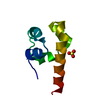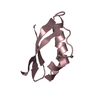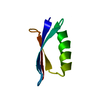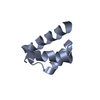Entry Database : PDB / ID : 2y9uTitle Structural basis of p63a SAM domain mutants involved in AEC syndrome TUMOR PROTEIN 63 Keywords / / / / Function / homology Function Domain/homology Component
/ / / / / / / / / / / / / / / / / / / / / / / / / / / / / / / / / / / / / / / / / / / / / / / / / / / / / / / / / / / / / / / / / / / / / / / / / / / / / / / / / / / / / / / / / / / / / / / / / / / / / / / / / / / / / / / / / / / Biological species HOMO SAPIENS (human)Method / / / Resolution : 1.6 Å Authors Sathyamurthy, A. / Freund, S.M.V. / Johnson, C.M. / Allen, M.D. Journal : FEBS J. / Year : 2011Title : Structural Basis of P63Alpha Sam Domain Mutants Involved in Aec Syndrome.Authors : Sathyamurthy, A. / Freund, S.M.V. / Johnson, C.M. / Allen, M.D. / Bycroft, M. History Deposition Feb 16, 2011 Deposition site / Processing site Revision 1.0 Aug 3, 2011 Provider / Type Revision 1.1 Jan 24, 2018 Group / Category Item _entity_src_gen.pdbx_host_org_ncbi_taxonomy_id / _entity_src_gen.pdbx_host_org_scientific_name ... _entity_src_gen.pdbx_host_org_ncbi_taxonomy_id / _entity_src_gen.pdbx_host_org_scientific_name / _entity_src_gen.pdbx_host_org_strain / _entity_src_gen.pdbx_host_org_variant Revision 1.2 May 8, 2024 Group Data collection / Database references ... Data collection / Database references / Derived calculations / Other Category chem_comp_atom / chem_comp_bond ... chem_comp_atom / chem_comp_bond / database_2 / pdbx_database_status / struct_site Item _database_2.pdbx_DOI / _database_2.pdbx_database_accession ... _database_2.pdbx_DOI / _database_2.pdbx_database_accession / _pdbx_database_status.status_code_sf / _struct_site.pdbx_auth_asym_id / _struct_site.pdbx_auth_comp_id / _struct_site.pdbx_auth_seq_id
Show all Show less
 Yorodumi
Yorodumi Open data
Open data Basic information
Basic information Components
Components Keywords
Keywords Function and homology information
Function and homology information HOMO SAPIENS (human)
HOMO SAPIENS (human) X-RAY DIFFRACTION /
X-RAY DIFFRACTION /  SYNCHROTRON /
SYNCHROTRON /  MOLECULAR REPLACEMENT / Resolution: 1.6 Å
MOLECULAR REPLACEMENT / Resolution: 1.6 Å  Authors
Authors Citation
Citation Journal: FEBS J. / Year: 2011
Journal: FEBS J. / Year: 2011 Structure visualization
Structure visualization Molmil
Molmil Jmol/JSmol
Jmol/JSmol Downloads & links
Downloads & links Download
Download 2y9u.cif.gz
2y9u.cif.gz PDBx/mmCIF format
PDBx/mmCIF format pdb2y9u.ent.gz
pdb2y9u.ent.gz PDB format
PDB format 2y9u.json.gz
2y9u.json.gz PDBx/mmJSON format
PDBx/mmJSON format Other downloads
Other downloads 2y9u_validation.pdf.gz
2y9u_validation.pdf.gz wwPDB validaton report
wwPDB validaton report 2y9u_full_validation.pdf.gz
2y9u_full_validation.pdf.gz 2y9u_validation.xml.gz
2y9u_validation.xml.gz 2y9u_validation.cif.gz
2y9u_validation.cif.gz https://data.pdbj.org/pub/pdb/validation_reports/y9/2y9u
https://data.pdbj.org/pub/pdb/validation_reports/y9/2y9u ftp://data.pdbj.org/pub/pdb/validation_reports/y9/2y9u
ftp://data.pdbj.org/pub/pdb/validation_reports/y9/2y9u Links
Links Assembly
Assembly
 Components
Components HOMO SAPIENS (human) / Production host:
HOMO SAPIENS (human) / Production host: 
 X-RAY DIFFRACTION / Number of used crystals: 1
X-RAY DIFFRACTION / Number of used crystals: 1  Sample preparation
Sample preparation SYNCHROTRON / Site:
SYNCHROTRON / Site:  ESRF
ESRF  / Beamline: ID14-2 / Wavelength: 0.9795
/ Beamline: ID14-2 / Wavelength: 0.9795  Processing
Processing MOLECULAR REPLACEMENT / Resolution: 1.6→22.249 Å / SU ML: 0.16 / σ(F): 1.32 / Phase error: 19.05 / Stereochemistry target values: ML
MOLECULAR REPLACEMENT / Resolution: 1.6→22.249 Å / SU ML: 0.16 / σ(F): 1.32 / Phase error: 19.05 / Stereochemistry target values: ML Movie
Movie Controller
Controller












 PDBj
PDBj











